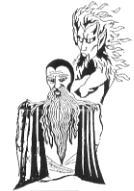

- Tradition of Western Secular Thought
• Tribute to individualism and the problems it causes, the indulgence of self as a solace to suffering
• How to reinvent yourself in midlife
• Shift from philosophical rationalism (man as thinker) to
historicism (man as doer)
• Faust torn between inner, outer life
• Poses universal questions: Where are secular
humans supposed to be heading? What is man striving towards (and
how does it affect the women in his life)? What's the point of
it all? What can ultimate knowledge and power do to a man (and
his knowledge of women)? What makes us human (or superhuman)?
- "Superman" (Übermensch, 490/15)
- Influence on other writers
- Great book, and therefore part of educated discourse
about art and literature
Margarethe:
Aka Gretchen (one of many nicknames for the
name Margaret: Meg, Gretel, Peggy, Maggie, Margie, Marge, etc.)
Mephistopheles: One of the devil's many reputed
names(2500/67). A shortened form of this name is Mephisto. According to the OED, Mephistopheles is a
fiendish person, esp. one who traps another into adopting a
disastrous or destructive course of action, and a tempter.
Mephisto embodies IRONY:
• Mephisto = master of
paradoxes, and his function = to personify dark side of
creativity, divinity.
• IRONY = Only by working on the devil’s side
can Faust create the good. By working w/the devil, he becomes a
better man.
alembic (6825/194) = distilling apparatus
de trop (4750/139) = too much
epicene (4900/143) = having characteristics of both sexes, effete
fluttering flibbet (11670/332) = what Mephisto calls Faust's soul;
in German, it is "die Flatternde, die Flüchtige" (literally
the fluttering thing, the thing flying away)
Magister (355-65/12) = master's degree,
combined with the equivalent of our B.A./B.S.
marmoset (Witch's Kitchen 2337 / 63) = a
Central and South American type of monkey with claws
pyromantic sport (5987/171) = the spectacle of fire that
Faust orchestrated probably with Mephisto's help at the end of
Spacious Hall
sepulchral (5352/154) = relating to tombs
sutler-woman (10530/299) = a camp follower in war who sells food
and washes clothes
Forest and Cave
(3355 - 3365/93)
Marthe's Garden
(3415/96 and 3510-20/98)
Night/Street in
Front of Gretchen's Door (3705/105)
Cathedral (3785/108)
Walpurgis Night (4185 - 4205/119)
Dreary Day and Night (no line #s/126)
Dungeon (4505-15/130 and 4610/133)
Charming Landscape
(4615-4725)
2. Imperial Residence
(4730-5060/139-46): (144-45/4890-5005: Meph., Chancellor,
Emperor, Treasurer + Quartermaster, Marshal, Astrologer, Muttering
all [6-7])
Spacious Hall/Carnival Masque (5065/147):
(172-74: Marshal, Quartermaster + Page, Emperor, Meph., Treasurer
+ Another, Faust, Chancellor + Baron [7-10])
5. Dark Gallery (6175/176)
(176-79/6180-6305: Faust, Mephistopheles [2])
6. Hall of Chivalry (6455/184)
(184-86/6453-6565: Lady + Another, 2nd Lady + Others + Diplomat,
3rd Lady + Knight + Poet, 4th Lady + Young Lady + Savant, Fifth
Lady + Older Lady + Astrologer, Sixth Lady + Oldest Lady + Faust,
Knight + Courtier + Meph., Chamberlain + the Former [8-22])
Classical Walpurgis Night (7005/199)
On the Upper Peneios (7080/202)
The Upper Peneios,
as before (7495/214)
Rocky Inlets of the Aegean Sea
(8035/228)
Inner Courtyard of a Castle (9130/259)
Great Outer Precinct of the Palace
(11511/327)
Goethe, J. W. v. Faust.
Trans. W. Arndt. NY: W. W. Norton, 2001. Print.